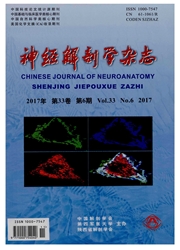

 中文摘要:
中文摘要:
目的研究琥珀酸对大鼠海马CA1 区的离子型Glu 受体介导的兴奋性突触后电流的调节.方法:采用红外可视脑片膜片钳技术,观察琥珀酸对大鼠海马CA1 区的谷氨酸(Glu)能自发兴奋性突触后电流(sEPSCs)和微小兴奋性突触后电流(mEPSCs)的调节作用.结果:琥珀酸能降低大鼠海马CA1 区离子型Glu 受体介导的sEPSCs 和mEPSCs 的电流幅度,而对其频率和半衰减时间均无影响.1 滋mol/ L 琥珀酸组sEPSCs 和mEPSCs 的电流幅度分别为(24. 16±2. 61) pA 和(23. 36±2. 73) pA,与对照组比较差异显著(P〈0. 01).结论:琥珀酸对突触前Glu 释放无影响,但可显著降低EPSCs 的电流幅度,琥珀酸可作为一种神经调质影响突触后兴奋性活动.
 英文摘要:
英文摘要:
Objective:To study regulation of succinic acid on ionotropic Glu-mediated miniature excitatory postsynaptic cur-rents ( mEPSCs) and spontaneous excitatory postsynaptic currents ( sEPSCs) in rat hippocampal CA1 neurons. Methods:The regula-tion of succinic acid on ionotropic Glu-mediated mEPSCs and sEPSCs in the rat hippocampal CA1 neurons were observed by using in-frared visual patch clamp technique. Results:Succinic acid could reduce the amplitudes of ionotropic Glu-mediated mEPSCs and sEP-SCs, but had no effect on the frequency and half-decay period. The amplitudes of mEPSCs and sEPSCs were (23. 36±2. 73) pA and (24. 16±2. 61) pA in the 1 μmol/L Succinic acid group, which had significant differences with control group (n=12, P<0. 01). Conclusions:Succinic acid has no effect on presynaptic Glu release, but can significantly reduce the current amplitude. Therefore, it may be a neuromodulator influencing postsynaptic excitatory activities.
 同期刊论文项目
同期刊论文项目
 同项目期刊论文
同项目期刊论文
 期刊信息
期刊信息
